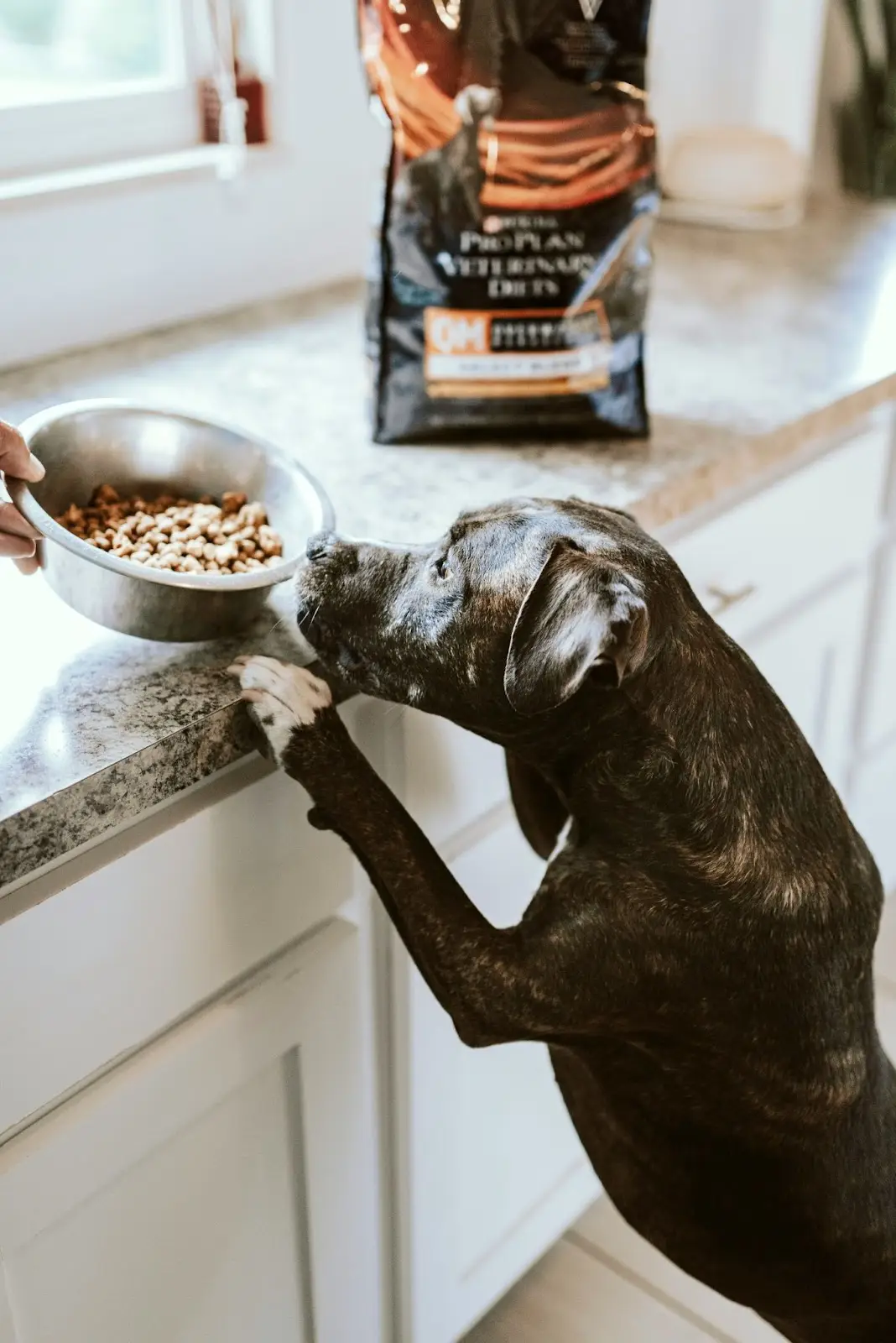Choosing the right type of food for your furry friend can be a daunting task. With shelves stocked with a plethora of options, pet owners are often left wondering whether to opt for wet vs dry dog food. In this article, we’ll dive into the differences between wet vs dry dog food and highlight their benefits and drawbacks. Additionally, we’ll explore how to switch your dog’s food and provide tips on choosing the right one. If you’re interested in exploring the best option for you, check out our recommendations of the best dog food.
What is the Difference Between Wet and Dry Dog Food?
The primary difference between wet vs dry dog food lies in their moisture content. Wet dog food has a moisture content typically ranging from 70% to 85%. This closely resembles the natural moisture content found in the prey animals that dogs would consume in the wild. This high moisture content aids in hydration and also makes wet food more palatable and easier to chew. This can be beneficial for dogs with dental issues or those who are picky eaters.
In contrast, dry dog food, or kibble, contains only about 10% moisture. The low moisture content makes it more convenient for pet owners because it has a longer shelf life and is easier to store. However, the lack of moisture in dry dog food can also be a drawback. Dry dog food may lead to dehydration in some dogs, especially those who don’t drink enough water. Additionally, the high moisture content in wet dog food can help dogs feel fuller faster, which may be beneficial for overweight dogs. Wet dog food also tends to have a stronger aroma, which can be appealing to dogs with a keen sense of smell.

Do Wet and Dry Dog Food Use Different Ingredients?
While both wet and dry dog foods offer balanced nutrition, their compositions can vary significantly. Wet dog food typically boasts higher levels of animal proteins and fats, which are crucial components for a dog’s health. These proteins often come from meat, poultry, or fish, providing essential amino acids that dogs need to thrive. The higher fat content can be beneficial for dogs requiring more energy or those with specific health needs.
Conversely, dry dog food often contains more carbohydrates and fillers to uphold its structure and texture. These carbohydrates can be sourced from grains like rice or oats, or from vegetables such as peas and sweet potatoes. This provides dogs with a great source of energy. While some carbohydrates are necessary for a balanced diet, excessive amounts can lead to weight gain and other health issues.
Moreover, wet dog food’s higher moisture content can aid in digestion which makes it easier for dogs to process nutrients. This can be advantageous for dogs with gastrointestinal sensitivities or those prone to urinary tract issues. The softer texture of wet food can also be beneficial for senior dogs or those with dental problems because it requires less chewing. On the other hand, the crunchy texture of dry dog food can help promote dental health by reducing plaque and tartar buildup. Pet owners find dry food more convenient because its lower moisture content allows them to leave it out for longer periods without spoiling.
Are There Benefits of One Over the Other?
Both wet and dry dog foods offer distinct advantages for pet owners and their furry companions. Wet dog food’s high palatability and ease of chewing make it an excellent choice for dogs with dental issues or those who are finicky eaters. Moreover, the high moisture content in wet food can aid in keeping dogs hydrated, which is particularly beneficial for canines that may not drink enough water. Additionally, the soft texture of wet food can be easier on the digestive system, making it a suitable option for dogs with sensitive stomachs.
Another benefit of wet dog food is its higher protein content, which is essential for muscle development and overall health. The increased protein levels in wet food can be particularly beneficial for active dogs or those with higher energy needs. Additionally, wet dog food often contains fewer carbohydrates and fillers compared to dry food, making it a suitable option for dogs that require a low-carb diet. Moreover, the higher fat content in wet dog food can provide a source of essential fatty acids, which are important for maintaining healthy skin and coat. Check out our picks of the best wet dog food of 2024.
Conversely, dry dog food provides convenience and cost-effectiveness. Its extended shelf life and ease of storage and handling make it a practical choice for pet owners with busy lifestyles. The crunchy texture of dry dog food can also contribute to dental health by reducing tartar and plaque buildup, although regular dental care is still necessary. Furthermore, the lower moisture content in dry dog food means that it is less likely to spoil if left out. This makes it a convenient option for pet owners who prefer free-feeding or have dogs that graze throughout the day.
Benefits and Drawbacks of Wet and Dry Dog Food:
Benefits of Wet Dog Food
- Higher moisture content helps keep dogs hydrated
- More palatable, making it ideal for picky eaters
- Easier to chew, making it suitable for dogs with dental issues
- Typically contains higher levels of animal proteins and fats
Drawbacks of Wet Dog Food
- Shorter shelf life once opened
- Can be more expensive than dry dog food
- Messier and less convenient to store and handle
Benefits of Dry Dog Food
- Convenient and easy to store and handle
- Cost-effective compared to wet dog food
- Promotes dental health by reducing tartar and plaque buildup
Drawbacks of Dry Dog Food
- Lower moisture content, which may lead to dehydration
- Some dogs may find dry food less palatable
- Contains more carbohydrates and fillers compared to wet dog food
How Long Can Each Be Left Out For?
It’s crucial to handle wet and dry dog food properly to ensure your dog’s safety and maintain the food’s freshness. Wet dog food should not be left out for more than 2 hours at room temperature to prevent bacterial growth. Any leftover wet food should be promptly refrigerated and used within a few days. This practice helps prevent foodborne illnesses and ensures your dog consumes fresh food. On the other hand, dry dog food can be left out for longer periods without spoiling. This makes it a convenient option for pet owners who need to leave food out for their dogs during the day. However, it’s still essential to store dry food in a cool, dry place to maintain its quality and prevent it from becoming stale or rancid. Properly storing and handling both types of dog food can help ensure your furry friend receives safe and nutritious meals.

Can You Mix Wet and Dry Dog Food?
Mixing wet and dry dog food can offer a balanced and enticing meal for your furry friend. This combination provides a variety of textures and flavors that can be appealing to dogs, especially picky eaters. It also allows you to customize your dog’s diet based on their preferences and nutritional needs. When mixing wet and dry food, it’s crucial to adjust the portion sizes to maintain a balanced diet and prevent overfeeding. Additionally, monitor your dog’s weight and overall health to ensure the mixed diet is suitable for them. Remember, every dog is unique, so it may take some experimentation to find the perfect blend that works for your pet.
How to Switch Your Dog’s Food:
When switching your dog’s food, it’s essential to do so gradually to prevent digestive upset. Begin by mixing a small amount of the new food with the old food, gradually increasing the proportion of the new food over 7-10 days until your dog has fully transitioned.If you’re considering changing your dog’s food, check out our in-depth article on how to switch your dog food.
How to Choose the Right Food for Your Dog:
When choosing a dog food, consider your dog’s age, size, activity level, and any specific dietary requirements or health issues. It is important to look for a food that is labeled as complete and balanced which mean that it contains all the nutrients your dog needs. Additionally, opt for high-quality ingredients and avoid foods that contain artificial colors, flavors, and preservatives.
Whether you choose wet or dry dog food ultimately depends on your dog’s individual needs and preferences. Both types of food can provide complete and balanced nutrition for your furry friend, so it’s essential to choose the one that works best for you and your dog.

